Sustaining principle of energy:
True hope resides in symbol use that embraces the reality of continuous, universal change and personal stewardship.
Delusive hope (misery) resides in symbol use that denies this reality.
Chapter six of Energy?! is a 2013 draft 22 cartoon exploration of the relationship between the human ego and the religious use of the “greenhouse” symbol.
Thesis
The icon of Earth in a greenhouse generates and reflects the cosmic beliefs and behaviour of its adherents in most profound ways. The image is so potent it has played a central role in the development of the Anthropocene.
One
Human beings have existed on Earth in some form or another for millions of years, living in relative harmony with the flows and balances that sustain humankind. However about the 17th century an unprecedented consciousness arose in Western Europe, the British Isles in particular. This spiritual revolution involves the grand delusion that all the biomass of the planet, both living and fossilized, exists to be burned for the short-term profit of the merchant oligarchy of this region. Thus began a Combustion Revolution of epic scale.
One byproduct of this global conflagration, also known at “The Industrial Revolution”, has been a great array of combustion-driven or derived machines that are designed to manufacture all manner of “commodities” for short-term profit. One product is sheet glass.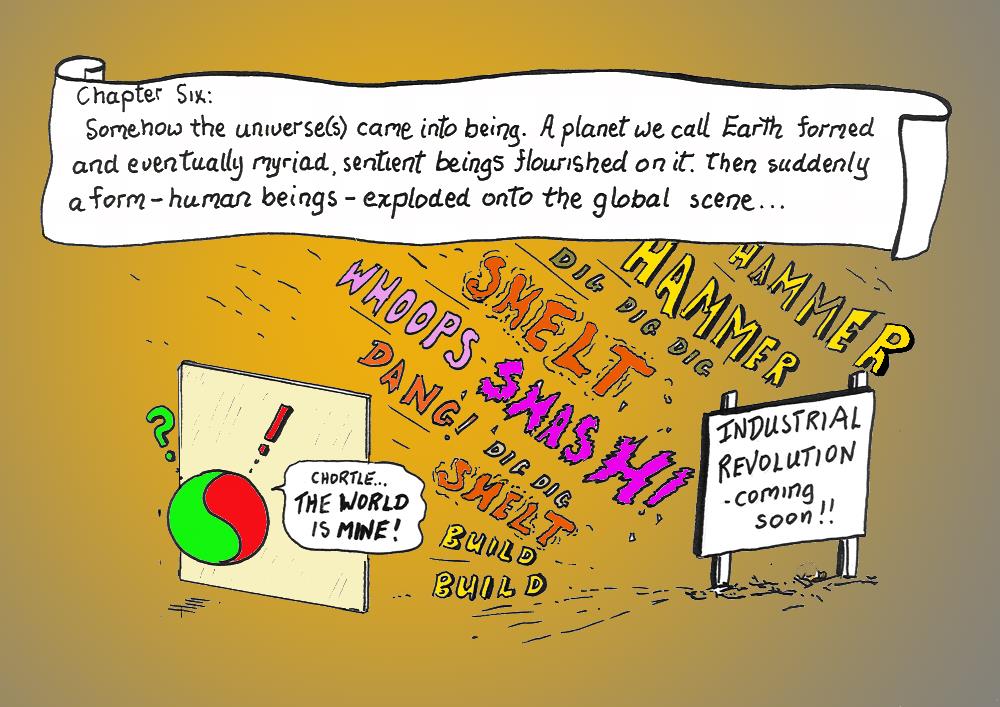
Two
Any technology has the potential to sustain or destroy us. So it is with glass.
When used with compassion, glass opens us to the wonders of the heavens, to the marvels of our cells, to the communication of up-lifting ideals and ideas, to our sustaining solar potential…we enjoy greater harmony with all.
When used according to the dictates of the ego, glass excludes us from all these possibilities. Instead the ego-driven use of glass tends to delude, demean, bankrupt, terrorize and even destroy us.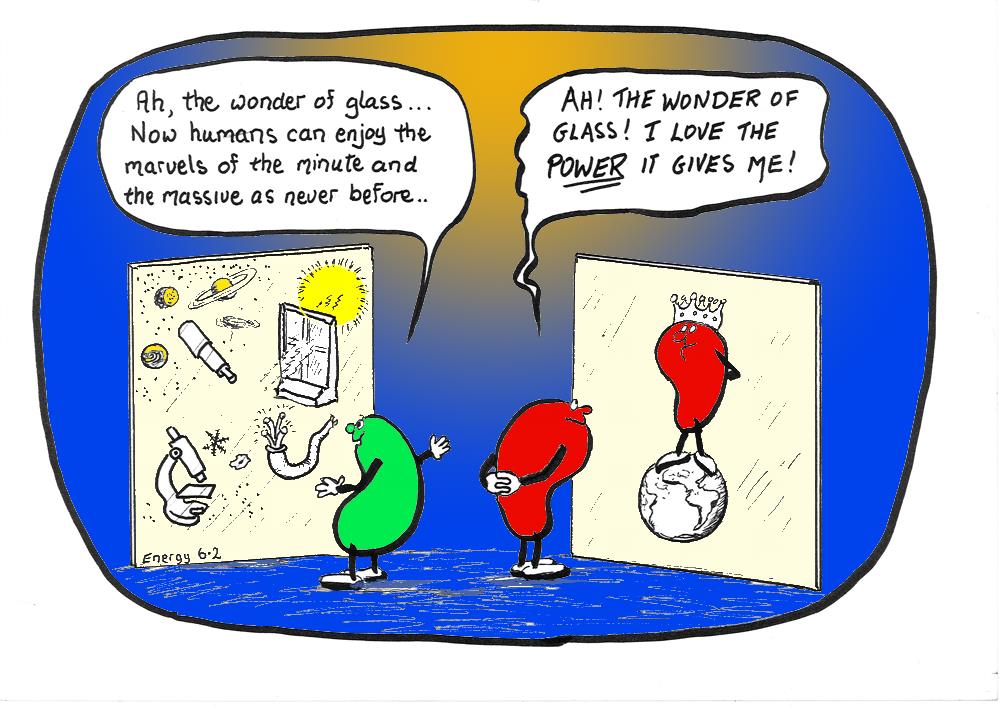
Three
The Combustion Revolution enabled the large-scale manufacture of iron machines, which in turn enabled steam engines, which in turn enabled the epic-scale extraction and combustion of biomass to power these devices, which in turn enabled all manner of manufacture, including sheet glass. The rich, feudal overlords of Western Europe soon began to compete among themselves as to who could own the largest glasshouse or “hothouse”. They vied to grow tropical foods and flowers in the freezing winters of Europe as proof of their might and prestige. Pity the poor servant child who failed to tend the glasshouse furnaces throughout the cold nights and these symbols of pomp and power became chilled and perished.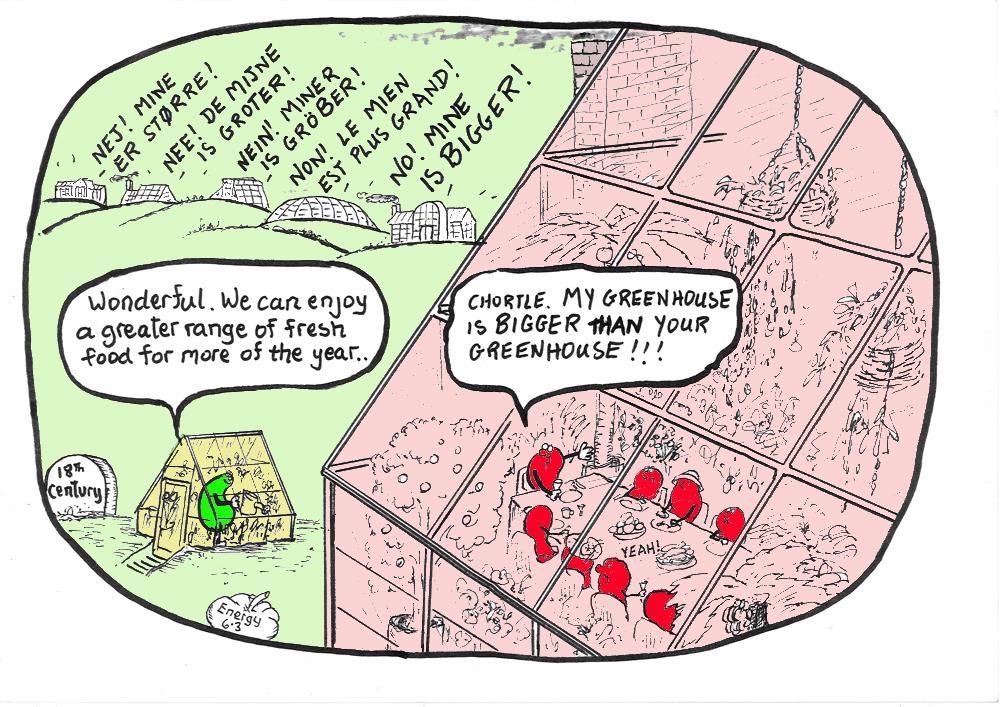
Four
The Combustion Revolution enabled a few merchant bankers to gain immense profits. However it meant enslavement, dislocation, pollution and mayhem for hundreds of millions of people around the planet, including many people of the British Isles. By 1850 Prince Albert, husband of Queen Victoria, was becoming very concerned that increasing unrest threatened the feudal structure of Britain. So he sought to engender a unifying sense of national pride by creating a great symbol of the might of the English Empire. This symbol, the Crystal Palace, involved a profound new theology. There were those who cautioned about the sublime arrogance of this radical, ego-driven religion. 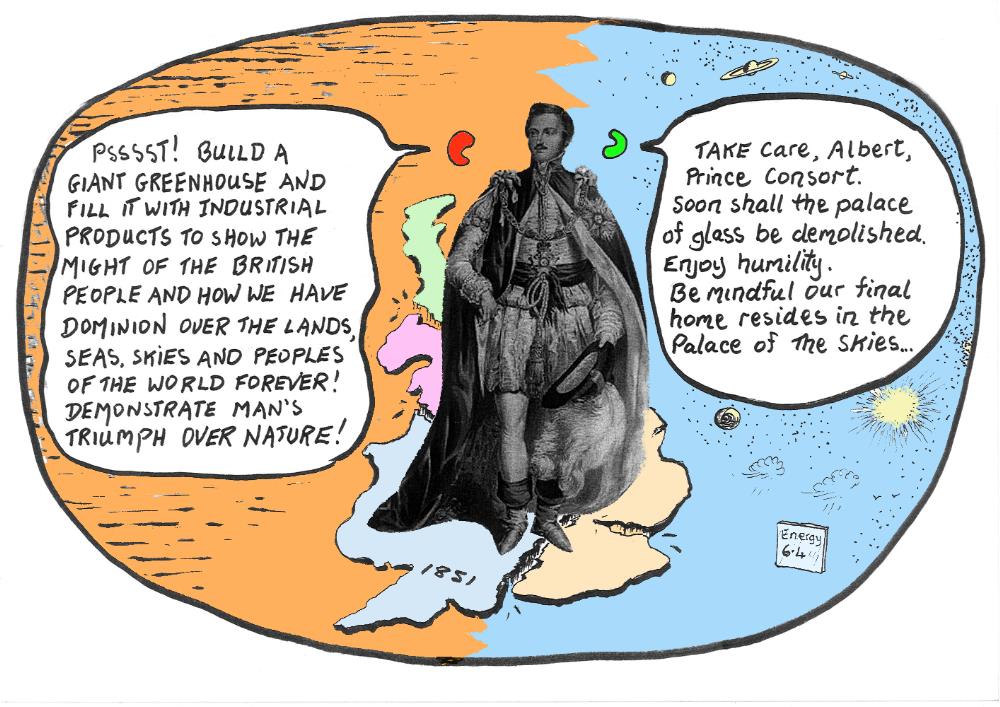
Five
Awe inspiring. Dazzling and even overwhelming the senses. Encasing large living trees and magical electrical machines. Encompassing the exotic with the familiar. Insulated from the changing weather. A marvel of the elegant use of iron and glass. A testimony to human creativity…
The Crystal Palace was the sublime realization of the delusions of the Combustion Revolution and Modernity. It soon spawned similar massive monuments of the ego around the planet in New York, Munich, Montreal, Toronto, Madrid and Brazil…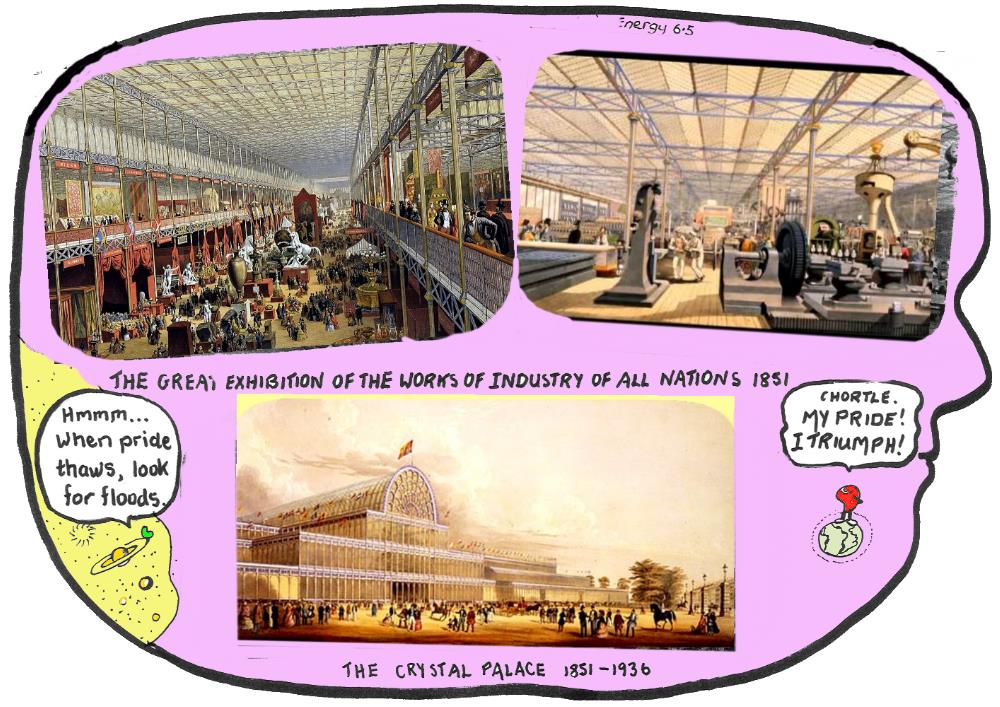
Six
Other new uses of glass enabled humans to see further, to magnify, to electrify, to observe chemical change, to measure climate change and, in general, to expand our senses as never before. This enhanced capacity gave rise to a radical new mathematics of thermodynamics.
It was easy for the ego to have English characterize this extended knowledge as the Age of Enlightenment even as the skies were filled with pollution.
The new technology and mathematics enabled deeper insight into the nature of Earth’s atmosphere and introduced the inconvenient possibility that human activity might be altering its essential life-enabling thermodynamics.

Seven
The ever ingenious ego commandeered these valuable insights into planetary thermodynamics and framed them in the language of greenhouses. This extraordinary deceit likening Earth’s atmosphere to a human construction conveniently asserts human beings can engineer Earth’s climate at will. This delusive hope is now so sophisticated, so extensive, so forceful that its believers have altered Earth’s climate on an epic scale. The language of the Greenhouse religion, empowered by an amoral notion of science, now pervades our media, especially our schools and Environmental Movement.
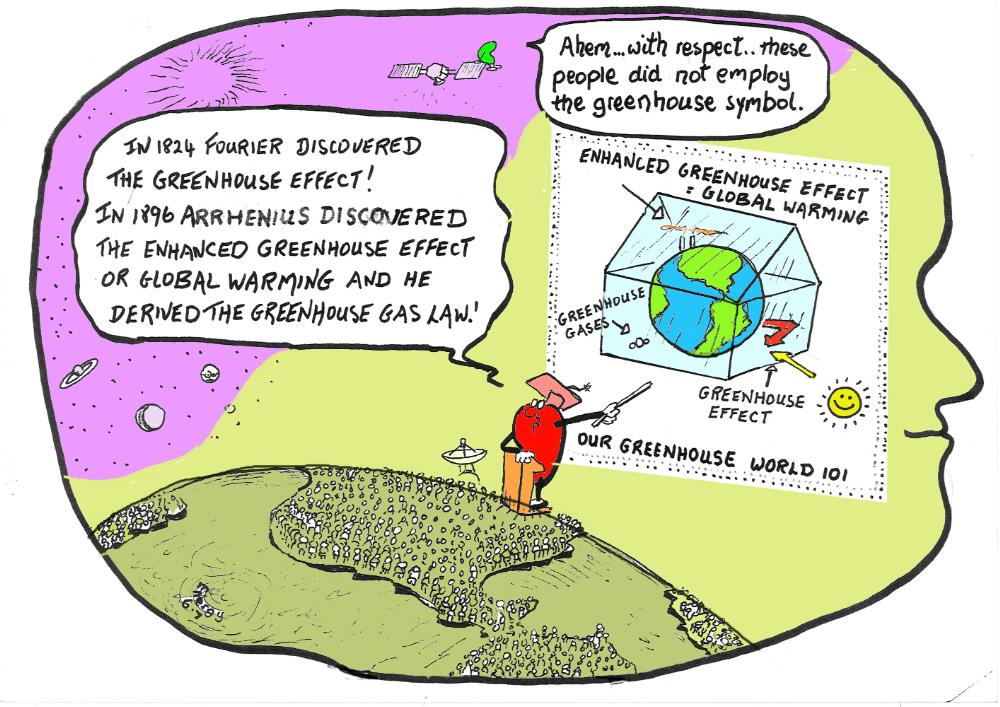
Eight
Earth’s atmosphere is an amazing and exquisite convective system involving winds in some regions of hundreds of kilometers per hour. Some hurricane or cyclone systems expend the energy of 10,000 nuclear bombs in their lifetime. As many climate care evangelists point out, we alter the thermal flows and balances of this dynamic system at our peril.
At the same time these well-meaning people revere the symbol of Earth in a greenhouse, a place of serene calm and controlled temperature. Indeed the symbol is so sacred to some educators and “climate experts” that they dismiss any person who dares question this use of the greenhouse image as a “nitpicker”, “conspiracist” or “”climate denier”.
Nine
The ego can have us say one thing, do the opposite and be oblivious to the dissonance. It can have us invert the meaning of a symbol and deny the change ever happened. The American Chemical Society’s irrational rationalization of the use of the “greenhouse symbol” is typical of the non-science of many of our most prestigious education institutions. It is an exemplar of how the ego can find any and all reason to justify our delusions.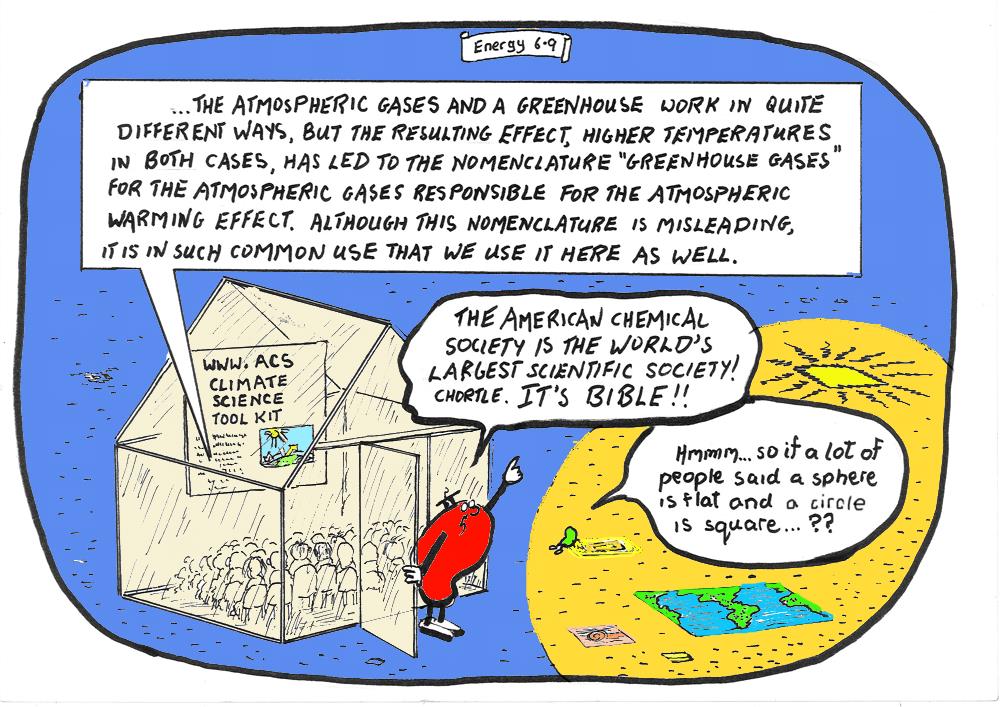
Ten
The ego has us think we need neither believe our senses nor inquire about our role as finite beings amidst the universal flux nor embrace the mystery of existence. Instead it has us believe it is the arbiter and repository of all knowledge. It instructs us we need not ask questions because it already knows the answer. It is the original and ultimate “know-all” – it has us believe There Is No Alternative (TINA) to its doctrine. The ego’s exclusive nature can pervade both individuals, institutions and societies alike.
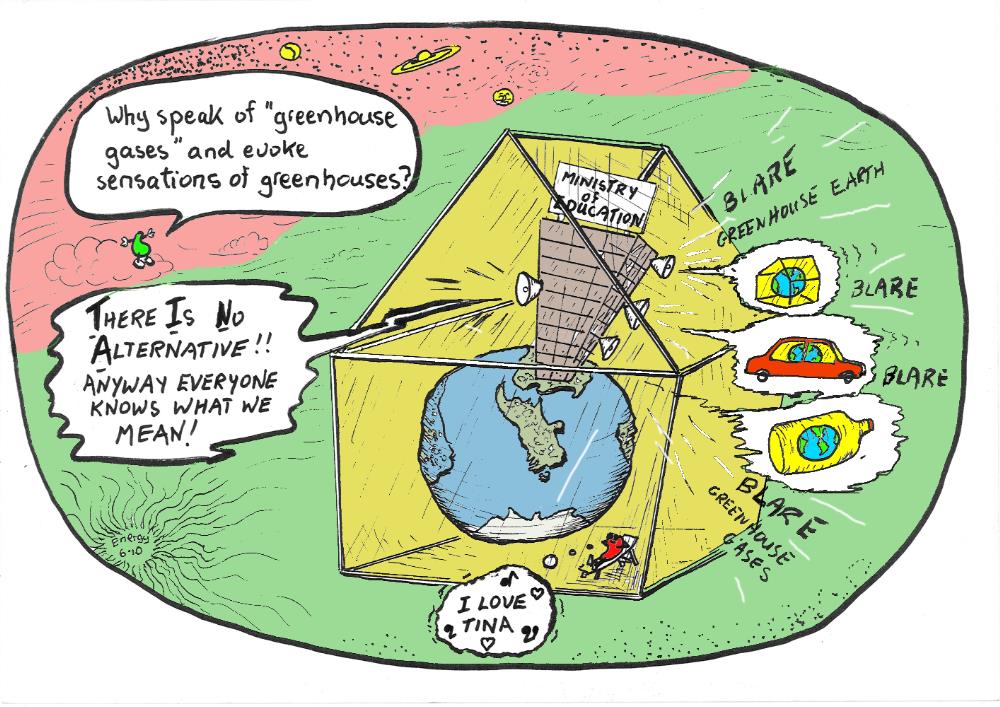
Eleven
The compassionate element of our psyche embraces the human condition with kind humour. It has unique capacity to transcend the incredible trickery of the ego. Compassion is inclusive and inquiring of nature, exploring the truth without fear and reminding us we are more mortal beings amidst the continuous universal transformation. It livens in us the awareness that every act we perform involves valuations according to the principles of physics.
The ego is of amoral nature and is in profound denial of the principles of physics. It can put a price on all things even as it does not know the value of any thing. It is inherently hostile to all notions of stewardship for they form inconvenient reminders of our mortality. Thus it acts to have us abrogate personal responsibility for our actions to all manner of abstract entities such as “The Market”.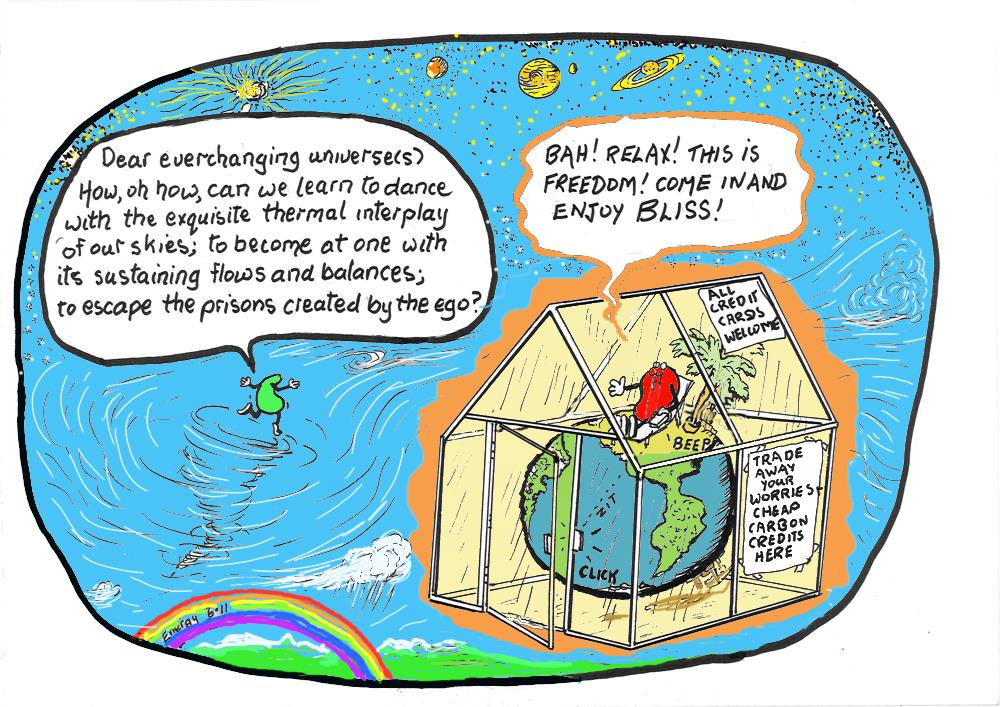
Twelve
Much of the cartoon script of Energy?! is direct quotes from our leading pedagogues and Climate Care experts. In 2000 I was charged with the awesome responsibility of summarizing the New Zealand Government’s 2000 Climate Change Impact Report into posters for 12 year old children in all our schools. At age 53 I was, for the first time, confronted with the stunning realization of the trace nature of life on Earth: life as we know it is sustained by an exquisite thermal balance enabled by a unique group of gas molecules constituting less than 0.1% of the atmosphere.
Incredulous at my ignorance and in disbelief at the astonishing leverage of these few gases I rang Martin Manning, then head of NIWA. He confirmed these shocking statistics and explained our society’s ignorance: no one talks about these molecules as trace gases. I determined hence forward I would no longer speak of them as Greenhouse Gases. I would instead symbolize them as the Warmer Trace Gases to remind myself and other people that these gases are vitally warmer than 99.9% of the gas molecules in our air, which retain minimal heat, and they act as the critical warmers of the planet’s surface. 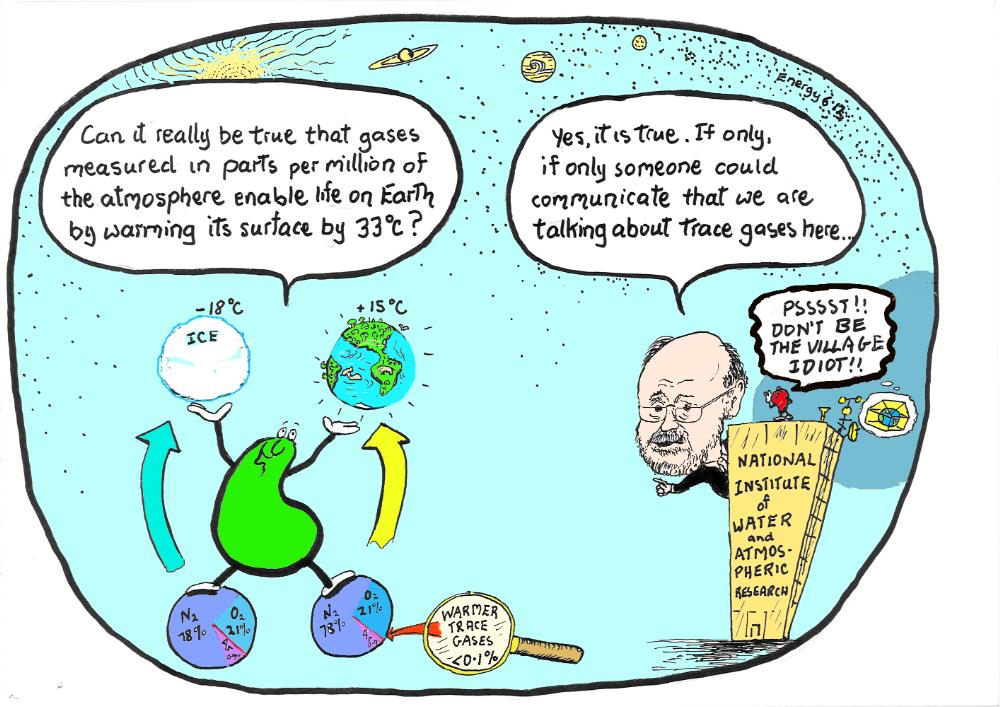
Thirteen
The decision to speak of Warmer Trace Gases opened my spirit to a greater and much more marvelous universe than I had ever imagined possible. I gave many months to exploring what learning activities our use of “trace gas” might generate in our schools for five year olds to post graduate students and their professors. Fundamentally it is an exploration of how to communicate to all ages that tiny changes to trace elements can generate massive change.
The decision also proved to be unexpectedly alienating. Pedagogues. Climatologists. Climate Care evangelists. Teachers. Journalists. They seem unanimous in their resistance to speaking of Warmer Trace Gases. Why?
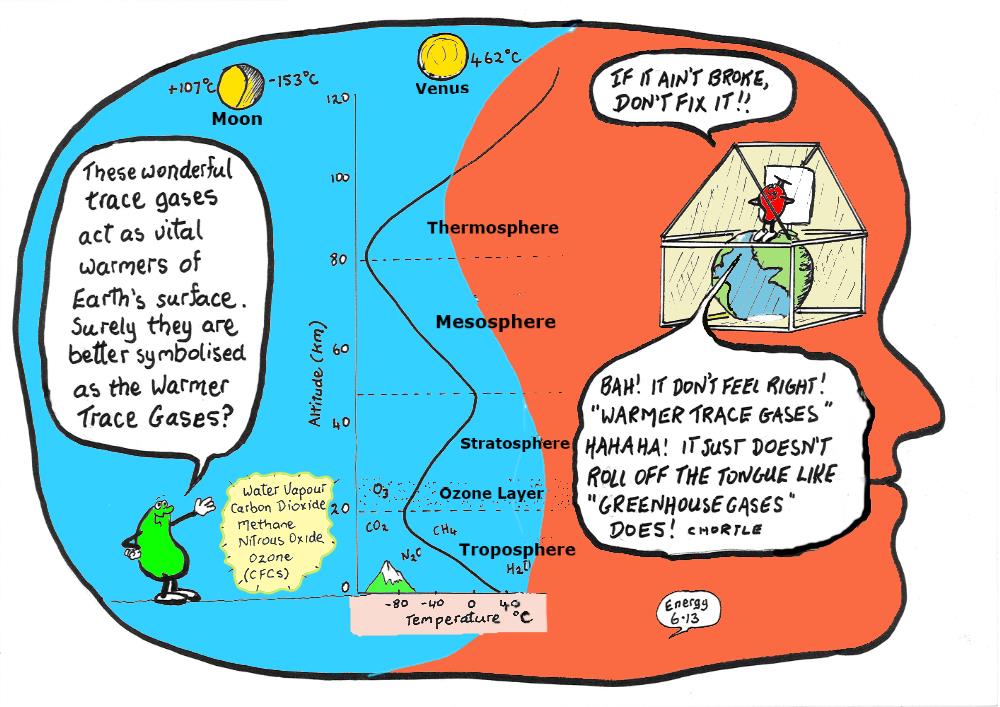
Fourteen
I also gave many months to exploring the learning activities generated at all levels of our education system by the use of “Greenhouse Gases” and eventually a common pattern emerged: all these “Greenhouse -Air” activities suppressed awareness of the essential thermal interchange of the universe. In other words, all the learning activities evidenced the denial of cosmic change and designs most characteristic of the ego.
The responses of most of our leading teachers tended to support this thesis that Climate Care education is primarily ego-driven – they responded to and dismissed this comparative research in most non-scientific ways.
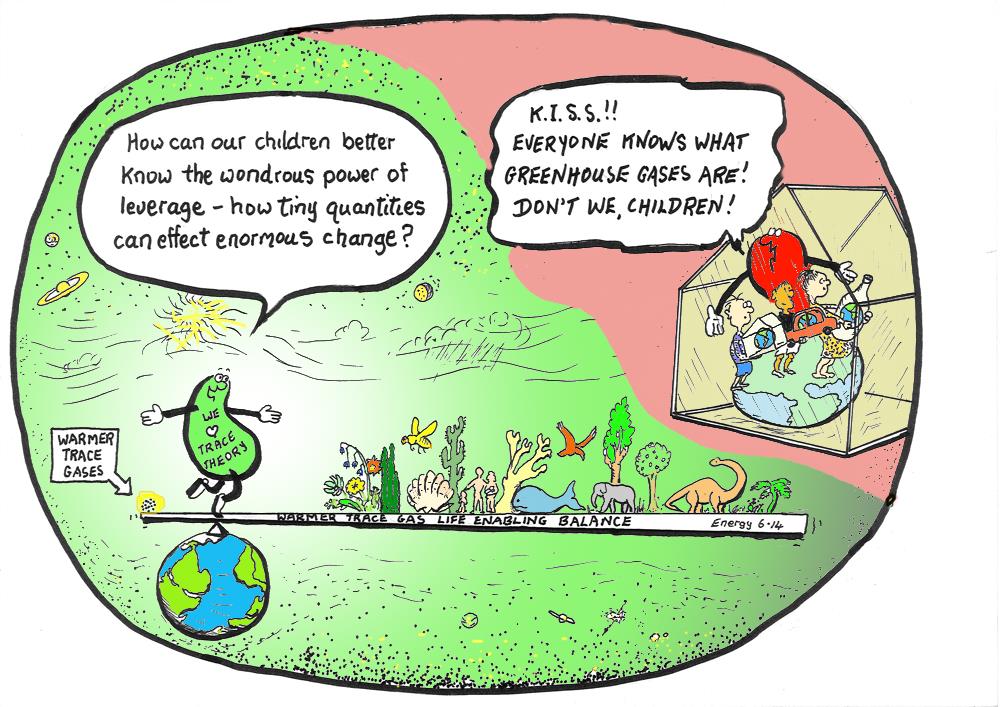
Fifteen
Government agencies such as the New Zealand Ministry for the Environment, the Parliamentary Commissioner for the Environment and the Climate Change Office, like their counterparts in other Anglosphere countries, frame much of our national discussion of climate processes. Their officials are exquisitely attuned to the dictates of the politicians, who in turn are attuned to the demands of powerful, ego-driven merchants. Ministry of Education officials find it convenient to rubber-stamp this framing and so it is that our children are taught non-science, such as “Earth’s atmosphere acts like a greenhouse” and “the three main gases are carbon dioxide, methane and nitros oxide”.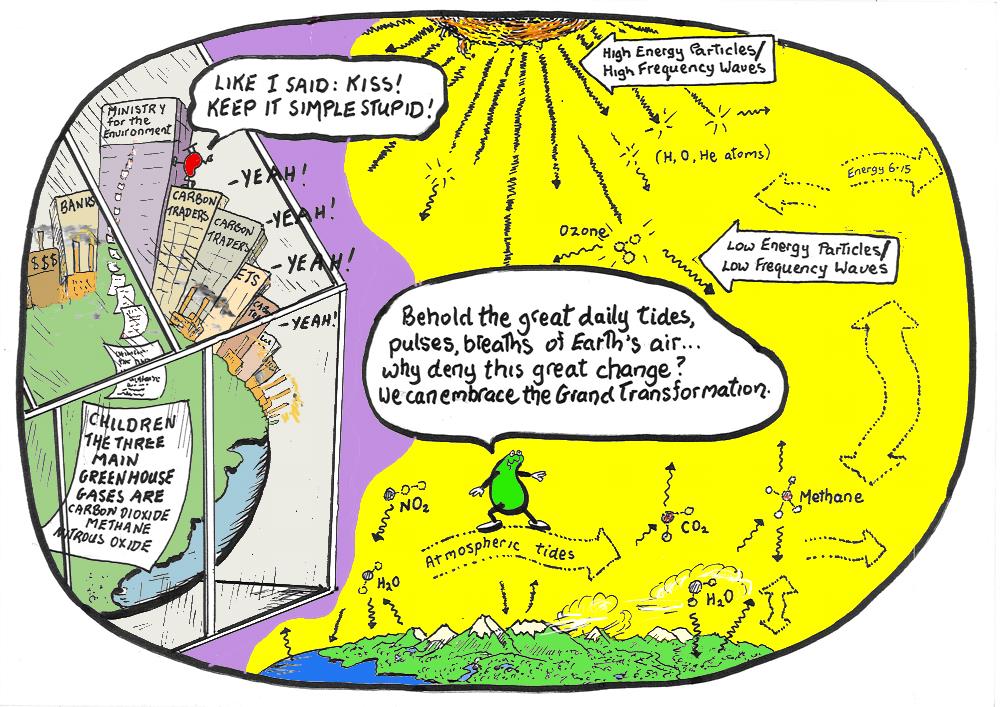
Sixteen
An axiom of education experts these days is that it is best to start with what the student already knows. Indeed many educators, especially Environmental Educators, use this axiom to justify their use of the “greenhouse” symbolization of Earth’s atmosphere – they argue children have direct experience of sunlit air trapped in a bottle, in a sealed car, in a closed greenhouse and in other human constructions.
Then in the next breath they insist the role of water in our atmosphere is beyond the ken of children even though every child begins their life swimming in fluid of their mother, lies in their cradle gazing at the clouds flowing overhead, begins jumping in puddles as soon as they can walk, chases rainbows as soon as they can run and has to replenish their Water Being daily for the length of their life.
Another triumph of the trickery and deceit of the ego? These well-meaning teachers warn that the activity of some humans is increasing the risk of extreme events such as droughts, floods, tidal surges, melting ice caps, ice storms and other water phenomena activity even as they deny the role of water in the process.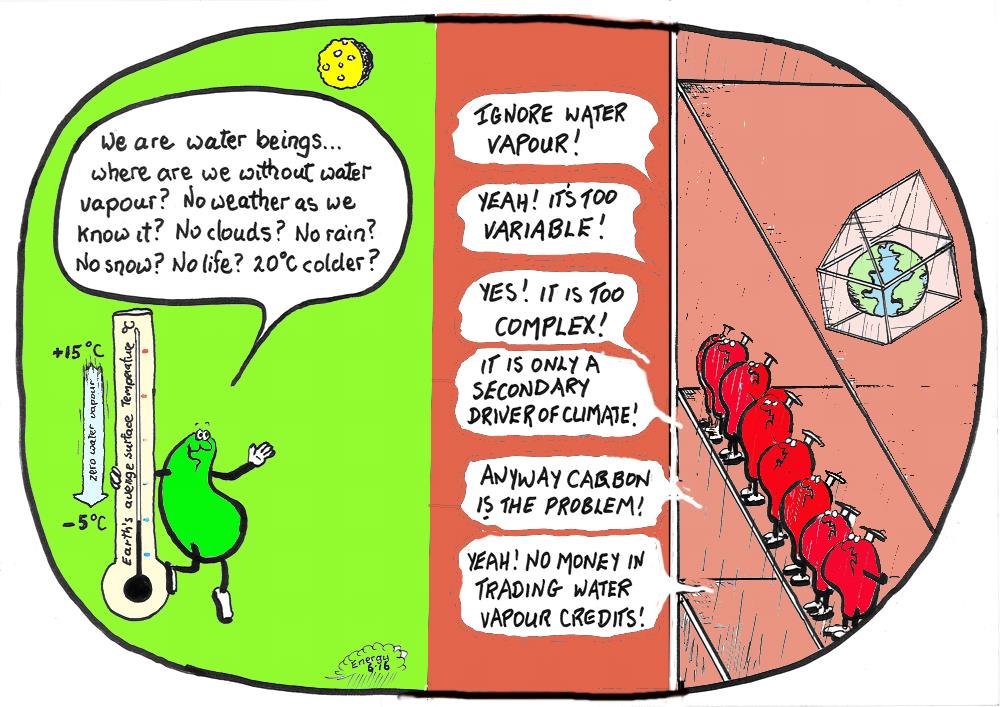
Seventeen
“Religion” is another product of radical transformation of the English language that occurred with the Combustion Revolution. It is a peculiarly West European notion since the 1700s and is not found in other cultures.
It arises from “religio”, meaning one’s “broad obligations to family, neighbours, rulers and even towards gods or God”. For many, this obligation involves the profound respect for the principles of physics.
Defining a religion as a “distinct set of beliefs or doctrines” removes reminders of our role as stewards amidst the universal flux.
This is very convenient for the ego, as was the simultaneous redefinition of “science” as just an amoral way of thinking, not a profound moral way of being.
The redefinition is also very convenient for the ego because it removes another reminder of “religio ”, which is “re-connection”. The ultimate – our re-connection with the cosmic reality -is a complete anathema to the divisive, exclusive ego.
The ego compounds these denials of reality by having us dismiss religion as fallible “spiritual practice” compared to infallible “rational science”. Adherents of the “Greenhouse World” belief system deny their world-view expresses their spirituality. Instead they cloak it with the authority of Science, thus giving the “greenhouse” symbol a potency that has generated an unprecedented ego-driven destruction of the planetary flows and balances that sustain humankind.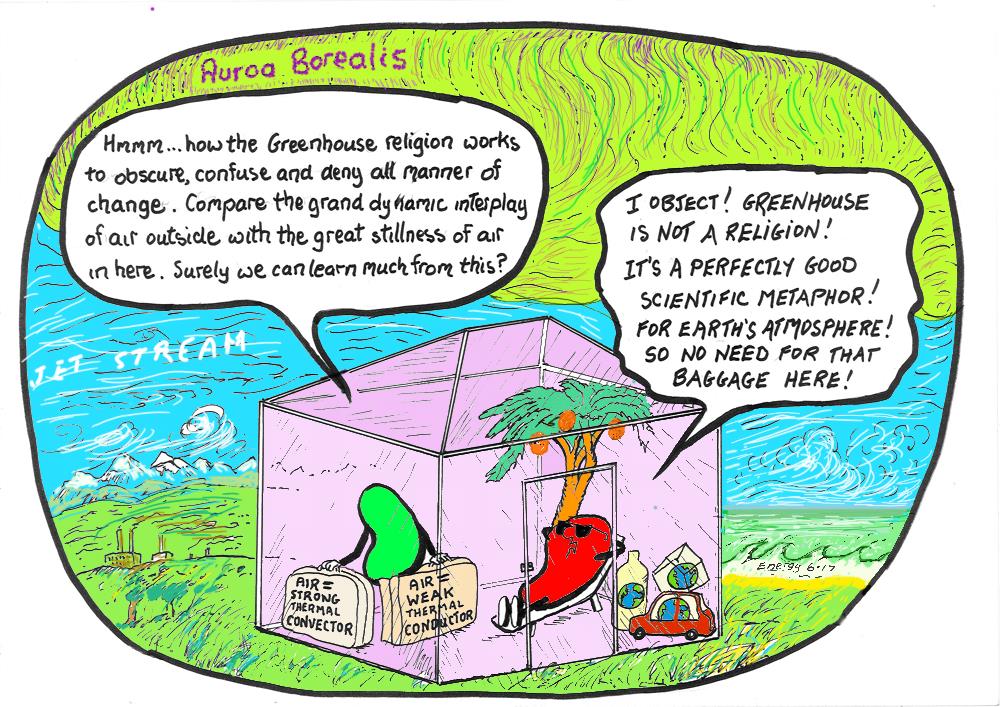
Eighteen
Two properties of air are critical for life, as we know it, to exist on Earth.
(1) Air is a good convector of heat.
(2) Air is not a good conductor of heat.
Winds moderate the surface temperatures of Earth by constantly transferring heat from warmer regions to cooler regions. Our planet’s maximum temperatures vary day and night, summer and winter between 58̊C and minus 88̊C whereas our moon, which has little atmosphere, varies between 100̊C and minus 173̊C each day.
We can use these qualities of air to further moderate our personal temperature by cladding our bodies and our buildings with materials designed to suppress air convection while exploiting the low conductivity of air.
The common image of a greenhouse is a structure of glass framed with wood or metal. Glass, timber and metals are much better conductors of heat than air, which makes the thermodynamics of a greenhouse very different to that of Earth’s atmosphere.
In brief, the ego can easily make any of our own worst enemy. So it is with our well-meaning “Energy” and “Climate Care” experts who preach the Greenhouse-Atmosphere doctrine. The former group obscures the vital convective properties of air in maintaining Earth’s climate while the latter obscures the valuable non-conductive properties of air when used in thermal insulation – including buildings made of glass, timber and metal.
Both groups teach against the objectives of the other group – a classic trick of the ego. They confound the principles of physics on scale.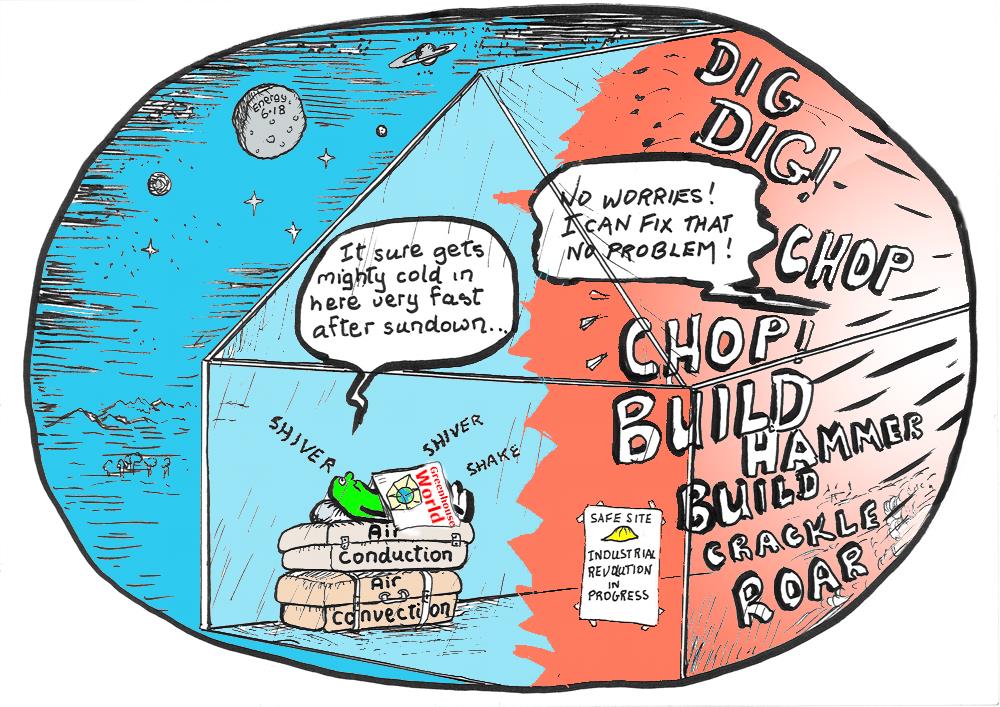
Nineteen
Without compassion, the deceits and cravings of the ego prevail. Without compassion, a minority of humankind can generate a global dystopia in the name of “freedom of choice”.
Without compassion, people destroy their neighbour’s sustaining solar potential and their society endorses, even lauds their actions.
Deceitful credit and delusive derivatives schemes abound, devoid of any true collateral. Waste and pollution form an ego-driven spiral to self-destruction.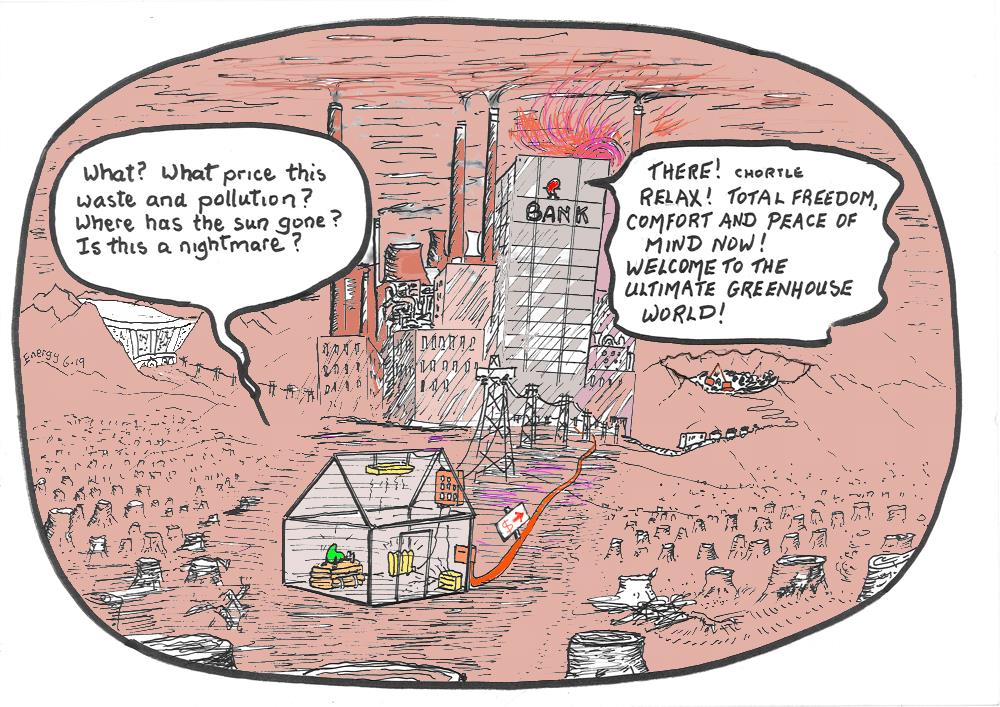
Twenty
Without compassion, deceitful credit and delusive derivatives schemes abound, devoid of any true collateral. Waste and pollution form an ego-driven spiral to misery and self-destruction. No society is exempt the rules of physics.
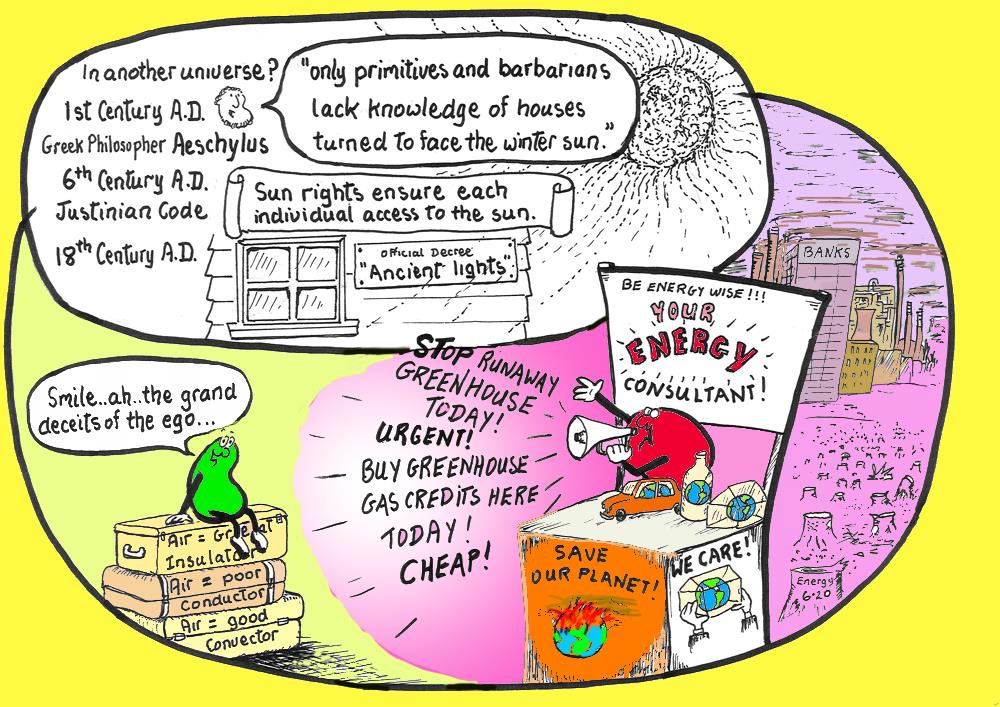
Twenty One
The Combustion Revolution- the radical doctrine that all the Earth’s biomass (living and fossilized) exists to be burned for the short-term profit of a minority of human beings -is testimony to the ego run beserk. We have the phenomenon that birds, bees and sheep have far greater comprehension of thermodynamics and live in greater harmony with our solar system than the most literate and numerate people of the Anglosphere.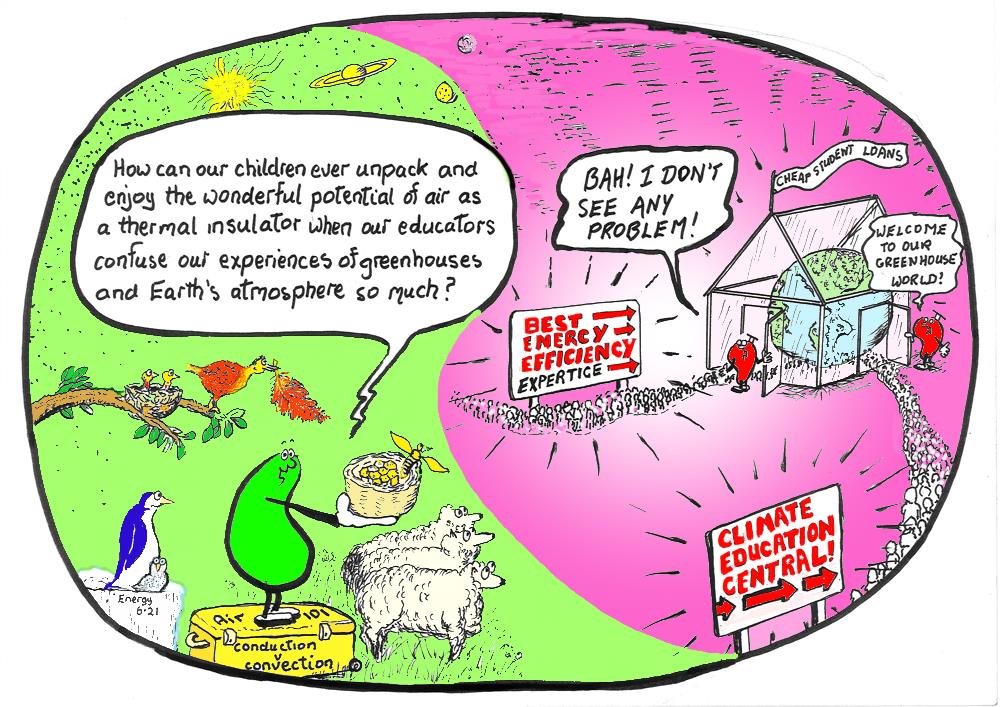
Twenty Two
These two complementary elements of the human psyche – our compassionate capacity and the ego – continue their discussion in Chapter Seven. Together they will explore our use and abuse of the “power” symbol, another great symbol underpinning the Combustion Revolution and its associated Anthropocene.
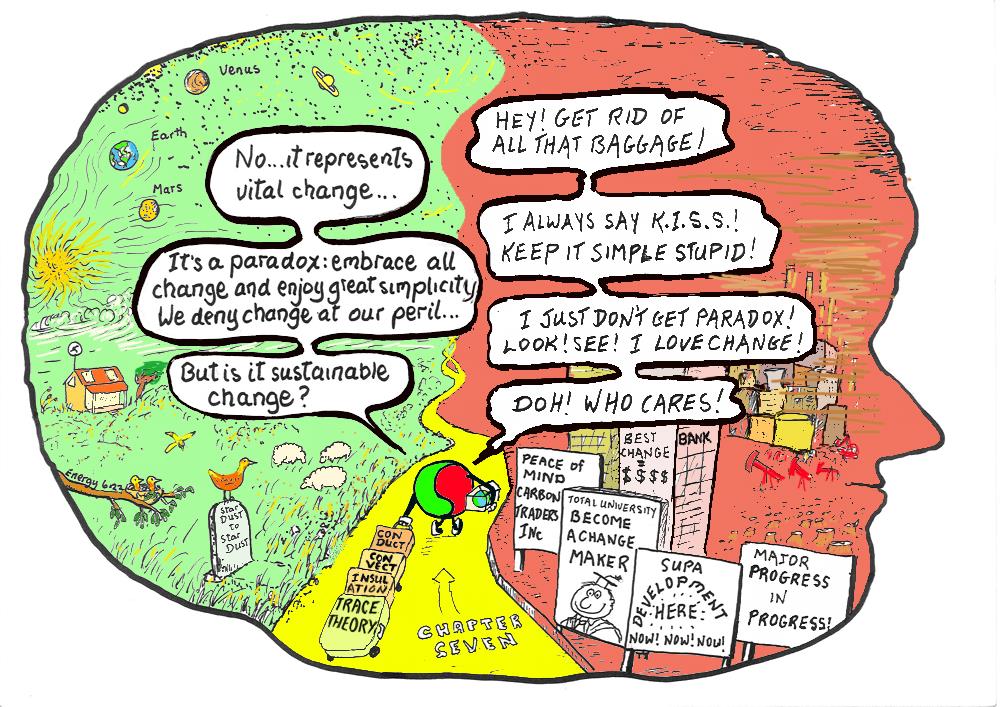
Chapter Seven Energy?! CARTOON history of “Power” symbol
Draft cartoon of Energy ?! Chapters 1-8 (Un-coloured, no commentary)
